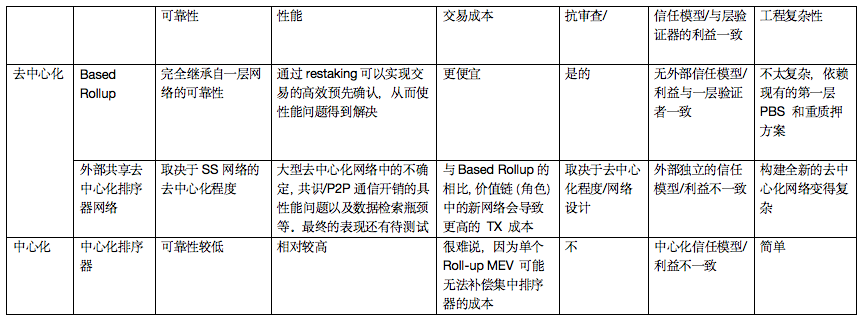The choice of decentralized transaction sequencer for Rollups (two-layer network): Shared sequencer network or Based Rollup?
Original author: James@PangaCapital
PangaCapital is a global early-stage investment fund focused on discovering, investing and cultivating high-quality Asian Web3 entrepreneurial teams. Its founding team has backgrounds from top exchanges, McKinsey, Morgan Stanley, PwC and other well-known institutions. The fund is committed to providing Asian entrepreneurs with access to global resources. Fund investors and partners include exchanges, leading overseas funds and market makers, well-known universities at home and abroad, and leading Internet companies.
As many Rollups (Layer 2 networks) have launched or are about to launch their mainnets, they are now facing a key question: how to choose a meaningful decentralized sequencer solution during the technical iteration process of Layer 2 networks. To replace the current centralized transaction sequencer. Currently, there are two main ways to implement decentralized sorters. SS (Shared sequencer network) network (external shared sequencer network) and based rollup that allows a layer of Validator to sequence layer 2 transactions. We will introduce each technology option on the market and compare the advantages and disadvantages of each option. We will conclude that based rollup (using the Validator of layer 1 to sort transactions in layer 2) is an appropriate choice for Rollup to implement decentralized transaction ordering.
1. External shared sequencer network solution
The external shared sequencer network is an independent network composed of sequencer nodes. The purpose of establishing the network is to provide decentralized transaction sequencing solutions for various types of Rollups. The network contains its own consensus layer, the DA layer of the P2P network transport layer, and the network allows transaction ordering nodes to join and leave the network without permission.
The benefits of using this technical solution are:
a. Increase total MEV return:If an external shared sequencer network can be applied to multiple rollups (layer 2 networks) at the same time, this network can capture cross-layer 2 MEV by sequencing multiple layer 2 transactions at the same time with certain rules. This gives the ability to discover and capture more MEV profit than just sorting a single layer 2. And the increased MEV profits can be distributed to each layer 2 network through the design of the token economy. (When the total pie gets bigger, everyone seems to benefit)
b. Prevent potential violations:When initiating transactions on the second-tier network (Rollu-ups) does not require permission, the second-tier network cannot determine whether the transaction is initiated by some sanctioned entity or whether the transaction itself is part of an illegal transaction. If the second-tier network builds its own sequencer, whether it is a self-built decentralized or centralized sequencer, the government may determine that the second-tier network plays a role in promoting illegal transactions. To avoid this, the roll-up (layer 2 network) requires an external decentralized co-sequencer network as a buffer.
c. Improve system reliability (liveness) and censorship resistance:All second-layer networks will decentralize transaction sequencers in pursuit of higher system online rates and censorship-resistant political correctness. And decentralization is also one of the important narrative features of the cryptocurrency industry. Therefore, using an external shared decentralized sorter network can simultaneously meet the needs of the above various purposes/interests.
Despite the above advantages, Shared Sequencer Networks (SSN) have many disadvantages that outweigh the advantages mentioned above:
1) Uncertainty of external trust model:For Rollup (layer 2 network), the external shared sequencer network is a network based on the external trust model. The external trust model cannot guarantee the same degree of decentralization as Ethereum, resulting in the reliability and censorship resistance of the second-layer network not achieving the desired results. And the solution itself that relies on the third-party trust model deviates from the original design intention of Rollup. Ideally, the second-layer network should not be based on any external third-party trust model, but only rely on the first-layer network (layer 1) to ensure the security, online stability and censorship resistance of the second-layer network.
2) The performance of SS networks is still questionable.
a. Consensus overhead:Even if nodes on the SS network only need to order transactions and not execute them, the network still needs to deal with consensus overhead (some SSNs use Hotstuff 2 as consensus to improve latency. But this consensus still has O(n 2 ) worst-case complexity Degree and O(n) communication overhead. In a highly decentralized network, the overhead of the consensus layer/P2P communication layer will have a negative impact on the performance of the SS network. The delay of SSN causes the second-layer network (Rollups) to be unable to obtain transactions quickly Sorting results. This will affect the effectiveness of the second-layer network to execute transactions and obtain the soft finality of the transaction. The user-side experience is poor and transactions based on soft finality cannot be completed quickly.
b. Communication overhead within the data payload SS network:In a traditional consensus protocol, nodes need to view the data of a block before the nodes vote to finalize the block. This data payload communication between nodes adds O(n(D)) latency to the protocol, which can severely degrade user experience if the number of nodes, N, is large.
3) Incentive inconsistency:There is a potential misalignment of interests between SS network nodes and nodes in the second-layer network that perform transactions and other roles. SS network nodes work exclusively for the SS network and receive incentives only from the SS network. This raises concerns that some Layer 2 networks may bribe SS nodes to refuse to serve other Layer 2 network transactions or to have discriminatory service order differences in serving multiple Layer 2 networks. .
4) Technical challenges in obtaining Cross Rollup MEV:Cross Rollup MEV is technically difficult to obtain. The SS network requires the transaction sequence of the second-layer network to be determined in a very short time. In such a short time window, the searcher needs to find the MEV opportunity that breaks the second-layer network and communicate with the transaction sequence proposer (Proposer) of the SS network in some way to insert the desired transaction into the transaction sequence. Correct location. Speed and accuracy are critical throughout the process, which poses significant challenges to searchers designing and implementing MEV algorithms
2. Based Roll -ups
Based Sequencing refers to a design in which the transaction sequence of the second layer is handed over to the proposer for the next block of layer 1 (Proposer for next block of layer 1) and the searcher of the first layer. The proposer of the next block of one layer (already determined in advance through committee election) will roll the block as part of the next block of one layer. In this case, the proposer of the next block at one level determines the order of transactions and rollup of the block, and proposes the block in the next epoch. At the same time, the formation of the second-layer block is completed by the second-layer PBS system, and the roles in it can also be played by the roles in the first-layer PBS. Such a design does not increase the load on Layer 1 proposers, but still obtains the expected benefits of a Layer 2 decentralized orderer.
Base Rollup has several advantages:
1) Better Liveness and censorship resistance.Only Base roll-up fully inherits layer 1 Liveness and Censorship Resistance, as it gives Layer 1 proposers the right to determine the order of Layer 2 transactions. This design eliminates the need for an external trust model for Layer 2, making Layer 2 less susceptible to any external influence.
In contrast, a Layer 2 network (Rollups) that relies on an external decentralized transaction sequencer will be vulnerable to poisonous MEV attacks if it encounters a short-term failure of the external sequencer. Transactions inside an escape hatch must wait for a period of time before settlement is guaranteed. Although the reliability of an external SS may be 99%, a 1% reduction in reliability can still be exploited in a malicious external environment
2) Consistency with the validator interests of the first-layer network/maximum MEV improvement possible(One floor + MEV across two floors).
Based Roll-ups returns the MEV acquisition opportunity to the first-layer verifiers by handing over the right to order the second-layer transactions to the first-layer verifiers, thus making the interests of the first-layer verifiers and the second layer consistent, and adding a layer of social capital, adding a layer of security. If all roll-ups adopt this model, Layer 1 searchers can search across Layer 2 + Layer 1 MEVs, resulting in greater MEV profits than a shared sequencer model that only covers cross-Layer 2 MEVs.
3) Lower user cost:When implementing a Base Roll-up design, Roll-up requires no additional charges to the external SS network. Layer 1 proposers and searchers and builders are compensated through MEV. In theory, other things being equal, transaction costs on Base Roll-ups should be lower than SS-based models because there is no external network involved in extracting value.
4) Censorship-resistant and regulatory-compliant.Base aggregation can remain censorship-resistant while complying with regulations.
The main drawback of based rollup currently is speed: people are worried about the throughput performance of based-rollup. Some people believe that the ordering work of Based-Roll up needs to wait until the blocks on one layer are finalized. In this case, the Based Rollup transaction confirmation time is directly limited by the block time of L1, resulting in very slow transaction completion from the users perspective.
However, there is a way to pre-confirm transaction ordering based on rollup. By restaking, the proposer of the next block of a layer can commit to including the Based Rollup block in the block of the layer they propose in the future. This is possible because the proposals for the next block in a layer are selected in advance. If the proposer of the next block does not propose the block as they promised, they will suffer a punitive token reduction through a restaking program. (Justin Decker, Summer 2023)
Some may find it challenging to convince Layer 1 validators to participate in Base Roll-ups. However, since all MEV flows are given to the layer 1 validator network, with appropriate incentives from layer 2 tokens, the interests of layer 1 validators are consistent with based rollup. Therefore, it should be relatively easy to get a layer of validators on board via re-staking.
All in all, Based Roll-ups can achieve pre-confirmation of transaction ordering to ensure system performance, and completely inherit a layer of reliability and censorship resistance without the addition of a new trust model. Therefore, Based Roll-ups is a better decentralized solution for transaction ordering compared to complex SS networks with external trust models.
Thanks to Daniel for providing his perspective, and to my colleagues Greg and Yao for editing and refining the content.
Lets put everything into the comparison table below:




